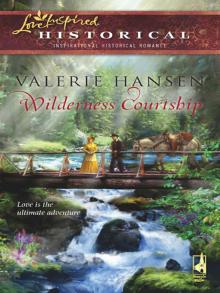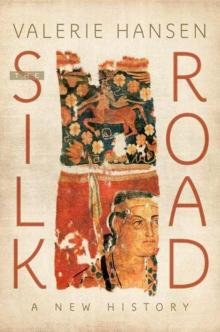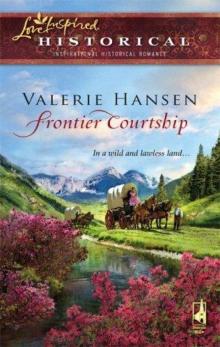- Home
- Valerie Hansen
The Silk Road: A New History Page 9
The Silk Road: A New History Read online
Page 9
A year after the arrival of the Third Expedition, the French scholar Paul Pelliot came to Kucha for an eight-month stay in 1907 when he collected many important documents in the local language of Kuchean. He also devoted one month to exploring the routes north through the Tianshan Mountains. Following the Muzart River north out of Kizil, he found two routes that connected the Tarim Basin with the grasslands to the north.9 These grasslands, spanning the northern half of Xinjiang (Zungharia), modern-day Kazakhstan, and neighboring Uzbekistan, were home to a succession of nomadic peoples, who posed a continuous threat to successive Chinese dynasties over the centuries.
Kucha’s location on the route to the grasslands of Central Asia led to its earliest appearance in official Chinese histories. When, at the end of the second century BCE, the emperor Han Wudi sent the general Li Guangli to visit the ruler of the Ferghana kingdom in modern-day Uzbekistan, he traveled via Kucha.10 Like the rulers of the Loulan kingdom, the rulers of Kucha did their best to maintain good relations with both the Han dynasty and its enemy, the Xiongnu confederation, which controlled the grasslands of modern Mongolia. Between 176 and 101 BCE, the rulers of Kucha acknowledged the superiority of the Xiongnu by sending their sons to live with them. It was customary for subordinate kingdoms to send their crown princes to live with their most important allies so that they could learn their language and familiarize themselves with their customs.
But when the Xiongnu weakened, the rulers of the Kucha kingdom shifted their allegiance to the Han dynasty in the first century BCE.11 The king of Kucha and his wife traveled to the Han-dynasty capital in Chang’an in 65 BCE, where they stayed for a year. In 60 BCE, the Han dynasty appointed a governor general, its official in charge of the Western Regions, to oversee its operations in Central Asia. This was the office that supplied the center with the information about different oasis kingdoms of the northwest, which is recorded in the dynastic histories. The official history of the Han dynasty gives the population of Kucha as 81,317, making it the largest oasis on the northern route.12 Little evidence of Han rule survives in the region itself. The Chinese headquarters were in modern-day Cedaya (Luntai County, Kucha), where the ruin of a Han-dynasty settlement has been found.13 In 46 BCE Kucha fell to the neighboring oasis state of Yarkand.
The constant jockeying for power among the different Central Asian states meant that the Han dynasty was able to keep control of its garrison only intermittently. The Han general Ban Chao was named governor general in 91 CE, and managed to reestablish Chinese control in Kucha and place members of the Bai family on the throne. But less than twenty years later, in 107, several oasis kingdoms rose up against Chinese rule, and the Chinese again lost control of the garrison. Starting at this point, and continuing in later centuries, the Bai family regained power and ruled Kucha, sometimes in their own right, sometimes after submitting to a neighboring power.
By the fourth century, when Kumarajiva was born, Kucha was an established center for Buddhist studies. Several translators with the family name Bai, most from the royal family of Kucha, participated in the translation effort. In the third century, the earliest dated evidence of Buddhism in Kucha,14 many were active in the Sarvastivadin school, which subscribed to Hinayana teachings.15 The residents of Kucha learned about Buddhism from Indian missionaries. The third and fourth centuries marked the peak of Indian influence, as illustrated by the ease with which Kumarajiva and his parents traveled between India and Kucha.
Kucha provided the perfect environment for the future translator to grow up in. The oasis kingdom had extensive ties with Gandhara, because the rivers across the Taklamakan led to the southern oases of Yarkand and Khotan, from where travelers crossed through the mountains to reach Gandhara. Kumarajiva’s father was an Indian prince, the son of a high minister, who left Gandhara so that he could pursue his studies of Buddhism at Kucha. When the king of Kucha pressured him to marry his younger sister, Kumarajiva’s father reluctantly assented to the match. The child of this union, Kumarajiva grew up speaking Gandhari and the indigenous language, Kuchean.
Kumarajiva’s mother was a devout Buddhist who did not want to live a married life. When Kumarajiva was seven years old, she requested permission to join a Buddhist order, but her husband refused. After she went on a hunger strike of six days, her husband gave in, and she entered a nunnery, taking Kumarajiva with her. Kucha was one of the few places outside India where women could take vows; one Buddhist text lists four nunneries at Kucha with between 50 and 170 nuns each.16
After studying in Kucha, Kumarajiva traveled with his mother to Gandhara to study texts with a Hinayana teacher. Kumarajiva then moved to what is now Kashgar for further study with a Mahayana teacher. He later returned to Kucha, where he converted some monks to Mahayana teachings. Although later Buddhist sources assert a sharp division between Hinayana and Mahayana teachings, the situation was much more fluid during Kumarajiva’s lifetime. When a young man entered the Buddhist order, he took vows from a monk ordained in a given Buddhist lineage. Membership in a lineage, like the Sarvastavadins, did not determine whether one followed Hinayana or Mahayana teachings. One could begin by studying Hinayana texts, as Kumarajiva did, and then study Mahayana texts. Monks who identified with the two schools lived side by side in the same monasteries and apparently saw no problem in doing so.17
COMMEMORATING KUMARAJIVA
An imposing bronze statue of Kumarajiva greets all visitors to the Kizil caves, evidence of the translator’s fame even today. In fact, we have no idea what Kumarajiva actually looked like. Since no portraits survive, the sculptor based this entirely on his imagination. Courtesy of Takeshi Watanabe.
Yet in practice some differences between Hinayana and Mahayana teachings were obvious. Where Hinayana monks believed that it was acceptable to eat meat as long as an animal had not been killed expressly to feed them, Mahayana monks refused all meat. One later traveler noticed that Kuchean monks ate meat, scallions, and leeks—all banned by Mahayana orders—and concluded that Kucha must be predominantly Hinayana.18
In 384, when Kumarajiva was around forty years old, his home city of Kucha fell to the armies of a general named Lü Guang. A description of the city at this time survives:
The city wall had three overlapping enclosures and was equal in area to Chang’an. The pagodas and temples inside numbered in the thousands. The palace of the Bai kings was imposing and lovely like the residence of the gods. The non-Chinese of the city lived luxurious and rich lives. Their homes had stores of grape wine verging on a thousand piculs [about 500 gallons, or 2,000 L] that did not spoil even after ten years. The soldiers drowned themselves in the wine of the successive households that stored it.19
After his forces took the city, Lü Guang sent Kumarajiva to his capital at Liangzhou (now Wuwei, Gansu) as an expression of his piety. Although Kumarajiva had taken a vow of celibacy, he was, the general believed, too great a teacher not to father his own children. Accordingly, the general made him drink too much and then tricked him into sleeping with a young woman. This is the first of three occasions on which according to Kumarajiva’s biographers he violated his vows.
Kumarajiva was kidnapped a second time, and was sent to modern-day Xi’an in 401 on the order of Yao Xing, the ruler of a regional dynasty called the Later Qin (reigned 394–416). Hoping that Kumarajiva would father his own “dharma seeds,” the king encouraged Kumarajiva to establish a household outside the monastery where he lived with multiple concubines. In a third incident, recorded in the official histories, Kumarajiva, of his own volition, requested a woman and fathered twins by her.20 Because of the strong conventions shaping Buddhist biographies, and the variations among surviving biographies of Kumarajiva, scholars are not certain whether these three incidents actually occurred. Still, these variant accounts, they concur, do show that around the year 400 CE laypeople were not surprised when Buddhist monks broke their vows of celibacy.21
Kumarajiva’s transgressions did not diminish his prominence as a Buddhist teacher. In 40
1, when Kumarajiva came to Chang’an, the ruler Yao Xing named him head of a translation bureau, which he directed until his death in 413. Kumarajiva’s lasting legacy was his translations of Buddhist texts from Sanskrit to Chinese.22 The best-known text of all of Kumarajiva’s translations was the Lotus Sutra, a Mahayana text that disparaged earlier Hinayana teachings and promised salvation to everyone who recited even a single verse.23
Although earlier translators had produced Chinese translations of Sanskrit originals, many of their texts contained so much technical vocabulary that only the few Chinese who had studied Sanskrit could comprehend them. Most of these early Buddhist translations were done in the same way: a Buddhist teacher, usually from India, recited a text he had memorized and explained its contents orally. His disciples then recorded what he had said in Chinese. The early system of translation caused many errors: the teacher could not read what his students wrote, and they could not be certain that they had understood him.24
Making translation particularly difficult, Chinese and Sanskrit belong to two different language families; Sanskrit, like other ancient Indo-European languages, is highly inflected. Verbs and nouns take a wide variety of forms, depending on their role in the sentence. A member of the Sino-Tibetan language family, Chinese is grammatically much simpler; nouns and verbs do not change form, with the result that the meaning of a sentence hinges on word order, with much resulting ambiguity. In 400 CE the best a language student could hope for was a bilingual text that gave the same sentence side by side in different languages.
Kumarajiva’s great innovation was to found a translation bureau whose staff could check the Chinese translations against the Indian originals. Their translations, credited to Kumarajiva, are famous for their readability. Even Chinese who did not know any Sanskrit could understand them, and the language flowed so beautifully that many Chinese readers preferred Kumarajiva’s fluent versions to subsequent, more accurate texts.
The successes of Kumarajiva and other translators made thousands of Buddhist texts accessible to Chinese readers, and they developed a system, still used today, of assigning certain Chinese characters and their sounds to represent each syllable of foreign words. This is the basis of the modern Chinese spelling system of pinyin, which renders Coca Cola as Kekou kele and McDonald’s as Maidanglao. Kumarajiva’s name was pronounced something like Kuw-ma-ladzhip.25 Due to changes in Chinese over the centuries, his name today is rendered in pinyin as Jiumoluoshi.26
The significance of this practice—of writing Chinese that incorporated elements of the spoken language to better capture the sense of the Sanskrit originals—caused Chinese itself to change. Victor Mair, professor of Chinese at the University of Pennsylvania, estimates that the vocabulary of Chinese expanded by as many as 35,000 words—not just Buddhist terms like the Sanskrit word for “sagacity” (prajna) but also secular words like “moment.” The encounter with Sanskrit also helped the Chinese to better comprehend the phonology of their own language. The Chinese, for example, did not realize their language was tonal, something first-year students of Chinese learn on day one. It was only at this time that they came to a systematic understanding of the tonal properties inherent in their speech.27
During the same centuries that Kumarajiva and his colleagues were working in Chang’an, other translators throughout Central Asia were engaged in the same long-term enterprise of making Buddhist texts originally written in Sanskrit available in local languages. One of the most important local languages was Kuchean, different in important respects from the indigenous language spoken in nearby Yanqi, called Agnean. Like so many research endeavors involving the Silk Road, the process of discovery has been fraught with setbacks, massive intellectual detours, and controversy. It required almost a century of scholarly work around the world to finally understand the relationship between these two languages.
The first hint that a lost language we now know to be Kuchean existed came in 1892. In that year, the Russian consul living in Kashgar purchased a document written in the familiar Brahmi script, known to scholars of Sanskrit, but in a language that was definitely not Sanskrit. The meaning of the text frustrated scholars for years. First, even after more texts in the same language were subsequently discovered, there was frustratingly little material to study: most of what survives today consists of individual leaf-shaped sheets of paper from different texts and some business and administrative documents on wood. Moreover, almost all of these texts are undated.28
Yet by 1908 two German scholars, Emil Sieg and Wilhelm Siegling, had deciphered the unknown language using a bilingual text giving the same school exercises word for word in Sanskrit and the unknown language. Sieg and Siegling did not know of any document giving the name of the language, so they chose one for it on the basis of a short colophon. (A colophon is a passage giving the name of each chapter of a text, the title of the full text, and the name of the text’s author and/or copyist. In addition it may give the date on which the text was copied and the name of the donor who paid for the text to be copied by hand.)
The colophon was for a Uighur, or old Turkic, Buddhist text entitled the Maitreyasamiti (Meeting with the Maitreya). Uighur is a Turkic language spoken by the peoples living in the grasslands of what is now Mongolia who moved into the Tarim Basin in the mid-ninth century.29 The colophon recorded that the text had been translated from the “Indian language” into “Twghry” and from “Twghry” into Uighur.30 “Twghry,” Sieg and Siegling concluded, had to be the Uighur name for the unknown language. Since the Maitreyasamiti text existed only in Uighur and the newly discovered language, it was a brilliantly plausible identification.
Sieg and Siegling went on to argue that Twghry was the Uighur spelling of Tocharian, the language of the Tocharoi, the ancient people known to the Greeks who lived the Bactrian region of Afghanistan, around the city of Balkh in today’s Pakistan. Further, they identified the Tocharoi with the Yuezhi, one of the tribes who founded the Kushan dynasty. Sieg and Siegling accepted the traditional Chinese account that, around 200 BCE, the Yuezhi broke into two groups, the Lesser Yuezhi in Gansu and the Greater Yuezhi in the Ferghana valley. Still, Sieg and Siegling could not explain why all the documents in the new language had been found on the northern route, far from either the putative homeland of the Yuezhi in Gansu Province or where they settled in the Ferghana valley of modern Uzbekistan.31
Later commentators have struggled to reconcile the account of Yuezhi migrations in the dynastic histories with more recent discoveries. One has suggested that, despite the wording in the histories, the original Yuezhi homeland was not limited to the Dunhuang region but extended across all of Xinjiang and Gansu.32 Another has proposed that the Yuezhi left Gansu speaking Tocharian but then switched to the Iranian language of Bactrian when they got to Afghanistan.33 Still, when the descendants of the Yuezhi arrived at Niya, they were speaking yet another language, Gandhari, which is an Indic, not an Iranian, language. All of these proposals cast further doubt on the traditional Chinese description of the Yuezhi migrations and on the accuracy of the name Tocharian.
In 1938 W. B. Henning offered a different, more persuasive explanation for Twghry. He noticed that the term “Four Twghry” (sometimes without the final y) appeared in a handful of documents in Sogdian, Middle Persian, and Uighur, composed sometime in the early ninth century.34 The term “Four Twghry” referred to a region spanning Beiting (Beshbaliq in Uighur), Turfan, and Yanqi, but not Kucha. Henning proposed that the Twghry language was originally spoken across the northern edge of the Taklamakan from Turfan and Beiting in the east to Yanqi in the west, but that it died out first in Turfan and Beiting, and then finally in Yanqi, where it was ultimately replaced by Uighur, the language still spoken throughout Xinjiang.35 Henning’s proposal has not been universally accepted, but it has the great virtue of accounting for the geographic distribution of documents in the Twghry language.
In fact, we know that the Yuezhi used Bactrian, an Iranian language written in Greek characters, as an of
ficial language.36 For this reason, Tocharian is a misnomer; no extant evidence suggests that the residents of the Tocharistan region of Afghanistan spoke the Tocharian language recorded in the documents found in the Kucha region. Although Sieg and Siegling were mistaken in linking the Twghry language with the Tocharoi peoples of Afghanistan, their name for the new language caught on.
Sieg and Siegling divided the surviving manuscripts into two dialects, A and B, separate languages now known as Tocharian A and Tocharian B. The two languages belong to the Indo-European family of languages: like Sanskrit, both were highly inflected, with a complex system of verbs and nouns that changed endings depending on their role in each sentence. Tocharian A and Tocharian B shared many vocabulary items, an indication that both diverged from an unknown common source language.
The eminent twentieth-century American linguist George Sherman Lane felt that the differences between the two languages were so great that the languages must have developed independently of each other for perhaps one thousand years, and certainly five hundred.37 Since Tocharian A and Tocharian B were in fact quite different, as different as French and Spanish are today, a speaker of one could not understand someone speaking the other.38
Given the region in which they were used—the northern route of the Taklamakan—it was logical to assume that the two Tocharian languages would share many elements with the Indo-Iranian branch of the Indo-European languages spoken in the neighboring regions of Iran and India. But the two Tocharian languages turn out to have much more in common with German, Greek, Latin, and Celtic than with any Iranian or Sanskritic languages. A professor of English at University of Idaho, Douglas Q. Adams, proposes that “it is possible, on the basis of these relationships with Germanic, Greek, etc., to ‘place’ Tocharian geographically in the late Proto-Indo-European world in some manner, say, between the Germanic (on the ‘north’?) and Greek (on the ‘south’?).”39 Adams’s tentative phrasing suggests that sometime in the distant past, probably between 3000 and 2000 BCE, the language that would develop into Tocharian A and B calved off from the mother language of Proto-Indo-European at a time between when German speakers and when Greek speakers left the Proto-Indo-European population. Given how little we know of ancient migrations, and the risks of using linguistic evidence to reconstruct migrations, we cannot identify a homeland for the ancient speakers of Tocharian before they moved to the Tarim basin. It is also possible that other Indo-European languages more similar to Tocharian A and B were spoken in Central Asia but that no material in these lost languages survives.

 Military K-9 Unit Christmas: Christmas Escape ; Yuletide Target
Military K-9 Unit Christmas: Christmas Escape ; Yuletide Target Marked For Revenge (Emergency Responders Book 2)
Marked For Revenge (Emergency Responders Book 2) Canyon Standoff
Canyon Standoff Trail of Danger
Trail of Danger A Puppy's Tale
A Puppy's Tale Marked for Revenge
Marked for Revenge Fatal Threat
Fatal Threat Christmas Vendetta
Christmas Vendetta Dangerous Legacy
Dangerous Legacy Blessings of the Heart
Blessings of the Heart Montana Reunion
Montana Reunion Her Montana Cowboy
Her Montana Cowboy Wilderness Courtship
Wilderness Courtship Rookie K-9 Unit Christmas
Rookie K-9 Unit Christmas Rescuing the Heiress
Rescuing the Heiress The Danger Within
The Danger Within Family in Hiding
Family in Hiding Love Inspired December 2013 - Bundle 2 of 2: Cozy ChristmasHer Holiday HeroJingle Bell Romance
Love Inspired December 2013 - Bundle 2 of 2: Cozy ChristmasHer Holiday HeroJingle Bell Romance The Silk Road: A New History
The Silk Road: A New History Search and Rescue
Search and Rescue Standing Guard
Standing Guard Small Town Justice
Small Town Justice Explosive Secrets (Texas K-9 Unit)
Explosive Secrets (Texas K-9 Unit) Threat of Darkness
Threat of Darkness Bound by Duty
Bound by Duty The Hamilton Heir
The Hamilton Heir Face of Danger
Face of Danger The Troublesome Angel
The Troublesome Angel Healing the Boss’s Heart
Healing the Boss’s Heart Deadly Payoff
Deadly Payoff Samantha's Gift
Samantha's Gift Her Cherokee Groom
Her Cherokee Groom Everlasting Love
Everlasting Love The Perfect Couple
The Perfect Couple Blessings of the Heart and Samantha's Gift
Blessings of the Heart and Samantha's Gift Nightwatch
Nightwatch Nowhere to Run
Nowhere to Run The Doctor's Newfound Family
The Doctor's Newfound Family The Rookie's Assignment
The Rookie's Assignment Frontier Courtship
Frontier Courtship Out of the Depths
Out of the Depths Special Agent
Special Agent Hidden in the Wall
Hidden in the Wall